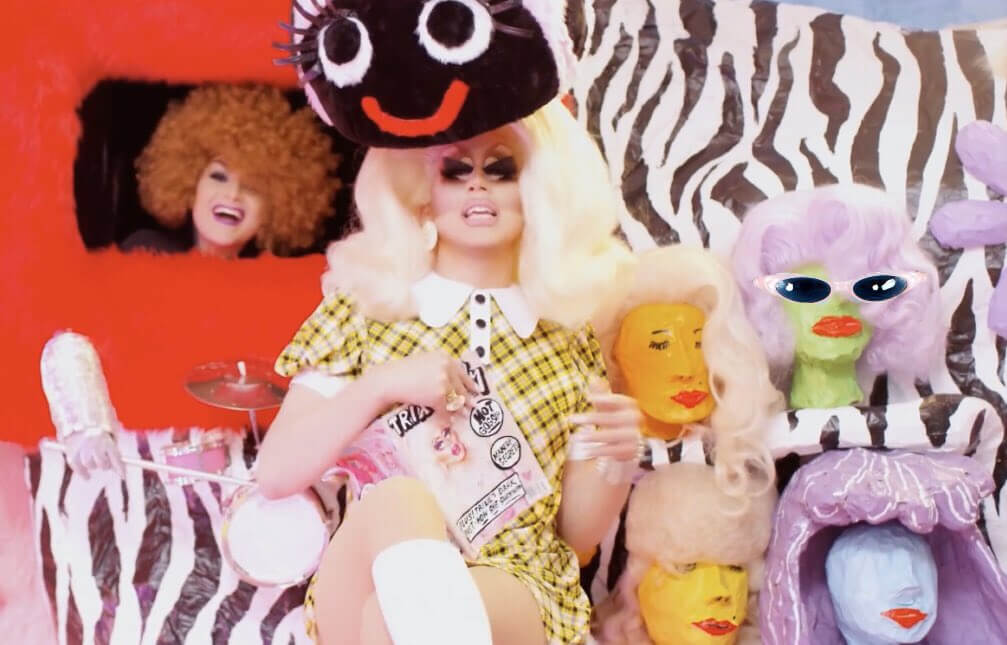Review of Trixie and Katya’s Guide to Modern Womanhood by Trixie Mattel and Katya Zamolodchikova
by Michael Quinn
In the tradition of great comedy duos that include Bill and Ted, Beevis and Butt-Head and Abbott and Costello, Trixie Mattel and Katya Zamolodchikova bring playfulness, nuttiness, and irreverent, off-the-wall humor to the lifestyle and self-help space with Trixie and Katya’s Guide to Modern Womanhood.
Trixie and Kaya are the drag queen alter-egos of Brian Michael Firkus and Brian Joseph McCook, who first sashayed across television screens in 2015 on the seventh season of the reality competition series RuPaul’s Drag Race,
Capitalizing on the success of both their subsequent YouTube series UNHhhh and their 2017 Viceland series The Trixie & Katya Show in which the two sit in front of a green screen and riff on a given topic (such as “Jobs Before Drag,” “Worst Hookup,” and “Dating”), silliness made side-splitting by some really inventive editing, the two bring the magic of their chemistry from the small-screen to the written page in their first full length book.
Alternating between short essays and transcripts of their tangential conversations—dedicated to “all the ambitious female scientists out there”—Trixie and Katya weigh in with thoughts on “Beauty and Style,” “Homemaking,” and “Relationships.”
“Television and folk music star” Trixie (the thirty-year-old Firkus) styles herself after a vintage Barbie, often dressing in pink, yellow, or florals paired with “a chunky white go-go boot” and a big blonde bouffant. Her signature makeup—giant, heavily-lidded panda eyes and extreme brown cheek contours—looks like something “from aisle seven of a terrifying toy store” as she was aptly introduced in the Pee-Wee’s Playhouse-inspired video for her sixties-meets-nineties bop “Yellow Cloud.”
Katya embodies a fantasy of “the only high-class Russian whore,” as she raps in the bitch track “Read U Wrote U” – blonde hair, red lips, short dresses, and “a high-end deathtrap of a hooker shoe.”
Self-described as “a passive-aggressive introvert with no boundaries or shame,” neurotic McCook’s Katya plays the straight man to the more confident Firkus’ Trixie. Beloved for her bonkers sensibility, Katya often has little plastic hands and bird nests sticking out of her wigs, and wanders in her thoughts. Quick-on-her-feet Trixie keeps her from straying too far by heading her off with a zinger.
The workload of the book has been divided evenly between the two. Katya’s attempts at humor seem more effortful, while Trixie takes a more natural, conversational approach. Katya covers hair while Trixie stresses makeup. In fact, she markets her own line of cosmetics available online and in selected stores. In praise of “cosmeceuticals” (one of three things targeted for rescue in the event of a fire, the other two being a mint in-the-box Malibu Barbie and a can of Red Bull), Firkus draws from experience working at a makeup counter. The tips here are surprising helpful (“Truthfully, your skin needs less makeup than you think”) while still punctuated by Trixie’s brand of humor. “The skin is your largest organ (unless you are my second boyfriend, Matthew—woof!).”
In their conversation on personal style (defining it as a point of view), the two express pet peeves (corsets as outwear, blue mascara) and point out that “your clothes can completely tell a story.”
Trixie notes, “For dressing in drag at least, there’s such a learning curve of learning your body, and what you have to do to your body to look like this imaginary body,” poignantly evoking the kind of dysmorphia experienced by trans folks, among others.
Writing about hygiene (“You can’t get clean off of yesterday’s shower”), Katya, often describing herself as “rotted,” notes, “The only time in my life when I adequately prepared for an important event was when I bleached my teeth before I appeared on television.”
There’s a recipe for vodka lemonade, quizzes about self-love and hoarding (“People are like goldfish. We naturally expand to the size of our fishbowls”), daily affirmations (“There’s nothing wrong with my legs and it’s okay that they’re always wet”), and advice on social media usage and interior decorating (“putting your home in drag”), in which Trixie relates words of wisdom from an older gay roommate, such as “Your home should never be louder than you are.”
The fun, colorful graphic design by Lorie Pagnozzi features lots of photo shoots of the heavily made-up pair. The smooshed crotch shots of Trixie and Katya in pantyhose evoke the so-wrong-it’s-right sensibility of comedian Amy Sedaris’ ode to entertaining, I Like You: Hospitality Under the Influence.
In Trixie and Katya’s Guide to Modern Womanhood, these pretend-women clearly relish their real, sizable audience’s attention, and brandish this mantle of authority like something they never expected to have. It’s like the unexpected catch that wins the game—it makes the victory so much sweeter. There’s humility here, which makes their trademark goofiness so affecting. What makes this duo comedy gold isn’t just the jokes. It’s because the source of that humor comes from an honest place. Their struggles are real and they share them (McCook, in recovery, manages to write about drugs in a way that’s not at all preachy), along with little anecdotes about the women who’ve inspired them, be they a hair colorist in a Wisconsin salon or an eccentric New England neighbor who carpeted her driveway with oriental rugs.
While Trixie and Katya obviously poke fun at playing the part of the “modern woman,” in some ways the culture’s moved so much, some women really are taking their cues from drag queens like them. Consider how mainstream drag has become. Drag Race, starting out in 2009 on Logo TV looking like it was filmed in a rec room by a camera with Vaseline on the lens, has since moved to VH1 and won multiple Emmys.
Still, it’s the queens that claim in spotlight, not the Brians, at least one of whom admits that “during the day I do not care to stand out, because I get all that attention in drag.”










